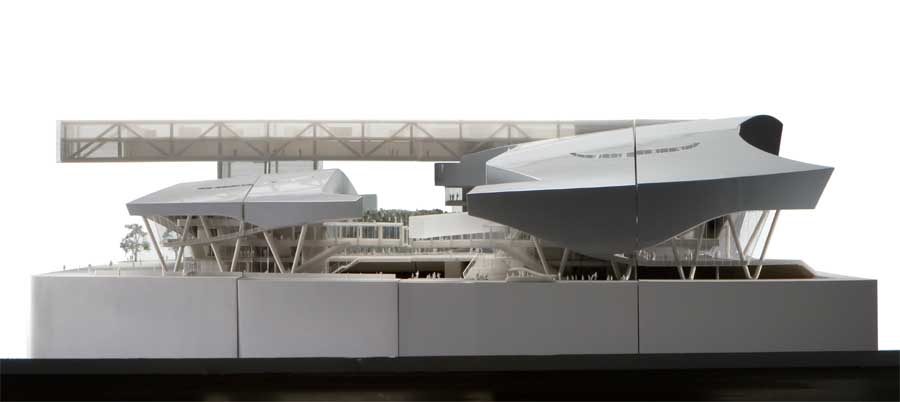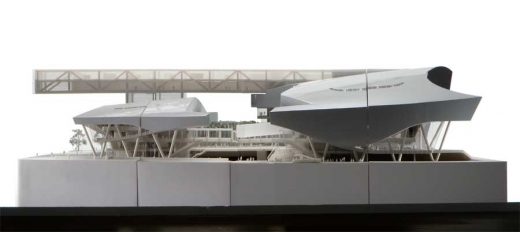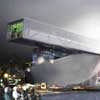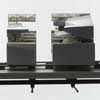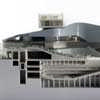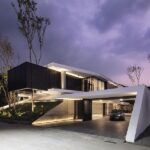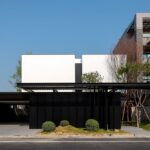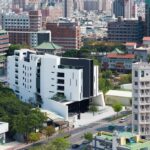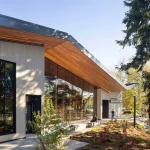Performing Arts Centre Taipei Entry, Design, Taiwan Theater Building Image
Taiwan Performing Arts Center
Taipei Architecture Competition Entry design by Morphosis Architects, Los Angeles, CA, USA
20 Mar 2009
“I believe that in a great city… a great theater is the outward and visible sign of an inward and probable culture.”
Sir Laurence Olivier, British actor, director and producer (1907- 89)
Design: Morphosis Architects, L.A., California
Taipei Performing Arts Center Entry : Morphosis
Historically, Taiwanese culture has encompassed a rich blend of Confucian Han Chinese, Japanese, European, American, southern Asian, and indigenous influences. This diversity, combined with Taiwan’s ongoing social and political struggle for self-determination, has forged a strong, distinctive and resilient national identity.
In the spirit of Taiwan’s time-honored cultural diversity, and its more recent social and political resilience, the Performing Art Center embodies a series of contrasts and counterpoints:
• Urban Connector AND Iconic Jewel
The Performing Arts Center stands out as an icon, its facets immediately identifiable from all corners of the city. Simultaneously, the complex is at one with its urban environment—seamlessly connected to its immediate surroundings, via public plazas, 24-hour linkages, dynamic facades and covered arcades. The complex is monumental in stature yet grounded in its context.
• Quotidian AND Symbolic
The Performing Arts Center embraces Taiwanese culture’s reverence for the theater as a fundamentally open art form. The Center is conceived not only as a ceremonial setting for theater as high art, but moreover as an inclusive “People’s Theater” that is woven into everyday life. Theater-goers, visitors, and passersby alike engage as both participant and observer in the public spectacle facilitated by the center’s overlapping variety of spaces.
• Regional Landmark AND International Destination
While specific to its local context, the Performing Arts Center provides a state-of-the-art, world-class facility, equipped to meet the highest international artistic standards. The project anchors Taipei’s new cultural axis and elevates Taiwan as a global nexus of cultural and social distinction.
Taipei epitomizes the boundless potential of the city, that most profound creation of humanity; it is the location of continuous regeneration, and a place of infinite possibilities. In the broadest sense, the new Performing Arts Center becomes the “great theater” that is “the outward and visible sign” of this great city.
URBAN CONNECTIVITY
Our proposal creates an environment that, amidst the dynamism and cacophony of the city, functions as a universe unto itself, while also seamlessly integrating with the physical, social and cultural fabric of its immediate context. Within walking distance of the lively Shilin Night Market, the historic Cixian temple, and the Zhongshan North green boulevard, as well as the TRTS Jiantan Station and major roadways, the Taipei Performing Arts Center anchors a round-the-clock cultural axis. The architecture becomes, by virtue of its sculpted and indelible form, a landmark in the region—like a jewel, with distinct facets visible from all corners of the city.
The proposal intensifies movement through the site and city, by strategically employing key elements, including:
• Pedestrian Bridge from Station
An elevated public walkway bridges Ji Ho Road, directly connecting the Taipei Rapid Transit System’s (TRTS) Jiantan Station to the Performing Arts Center. The bridge slips over the station’s notable structure and between the station’s dramatic structural tension cables. The visitor ascends an escalator to the glazed pedestrian bridge across Wen Lin Road. After crossing over the road, the visitor has the choice to descend to the main public plaza or to continue through the 24-hour walkway to Cheng De Rd.
• 24 Hour Public Urban Connection
The 24-hour enclosed pedestrian linkage serves as a new urban connection between the TRTS station and Cheng De Road, independent from the operating schedule of the theaters. As pedestrians traverse the walkway through the building, views open up to the city beyond, and elements of the life of the Performing Arts Center reveal themselves sequentially. Whether a passerby catches a glimpse of the spectacle of theatergoers dining at intermission or a sneak peek of scenery construction and costume creation, this dynamic experience of the behind-the-scenes action amplifies citizens’ connection and exposure to the theater—reinforcing the Performing Arts Center’s role as a People’s Theater, and the theatergoers’ experience of life-as-theater.
• Public Plazas
The elongated Wen Lin Road façade lifts up to create an iconic gateway, announcing the entry to the Performing Arts Center’s public plazas. In the core of the complex, the ground plane peels into two public plaza levels: an undulating landscaped plaza, half a level above grade, and a covered commercial plaza, a meter below grade. The upper plaza affords green space in the middle of the city, and connects to public cafes, roof gardens and decks. Surrounded by an arcade of shops, vendors and restaurants, the lower plaza provides a vibrant commercial zone that draws in the activity of the Shilin Night Market to the north. A grand public stair, the width of the entire plaza, leads from the lower plaza directly to the Multiform Theater.
• Covered Arcades
In response to Taipei’s climate and urban condition, covered arcades line the center’s facades along Wen Lin Road, beneath the projected theater volumes, and along Cheng De Road. The tree-shaded green boulevard that lines the southeastern edges of the site relates to the gracious colonnade of trees along nearby Zhongshan N. Road.
• Cheng De Road Western Façade
The public character of all of the Performing Arts Center’s façades and public spaces activates the sidewalk and contributes to Taipei’s lively street life. The western street front is glazed to afford views of back of house functions. This expansive “storefront window” extends the length of the entire city block, to serve as an information display for the theater complex at an immense urban scale.
• North Façade – Urban Amphitheater
The northern façade cants and curves inward, like a concave “lens,” to harbor an urban amphitheater. The amphitheater’s seating rises up from the sidewalk, and looks toward the neighboring Bailing Senior High School playing field. This urban gesture gives back to the city, affording shared performance space to the school and the theater complex for public events.
• Glazed Administrative Bar & Display Screens
A glowing, glass-encased bar, capped with a two-story media display, emerges from the Grand Theater mass and projects dramatically over Jian Tan Road, to denote the center as a beacon. Photovoltaic panels cover the bar’s entire top surface. The bar’s double glazed skin affords both efficient ventilation and views to the city for the administration offices housed within. While the exterior glazed layer acts as an insulation layer to reduce heat gain, the inner layer utilizes operable vents to allow users immediate control of their environment through natural ventilation, drawing air indirectly from the exterior. Together with the photovoltaic panels above, this unique façade configuration signals a deep commitment to sustainability and energy efficiency.
The ROLE & ORGANIZATION of the new Performing Arts Center
In Taipei, the theater is not an amenity reserved for the cultural elite, but is truly open to the entire community. Our proposal celebrates both conceptions of theater: theater as high art, embodied by the sumptuous formal foyers leading to the striking Grand Theater and the intimate Proscenium Playhouse; and the inclusiveness of a “People’s Theater,” exemplified by the Multiform Theater’s overt and deliberate connection to the public. The differentiated form, material language, and spatial layout of each of the three theaters align with their respective roles. Each theater’s distinct form in turn directly inflects the form of the overall building envelope and the complex as a whole.
• Public Spaces: Life as Theater
Responding to Taipei’s culture of inclusiveness in the theater, the new Performing Arts Center is literally a theater “of the people.” In the tradition of Garnier’s Paris Opéra and Sharon’s Berlin Philharmonic, life becomes theater. In the public spaces, visitors become part of the theater everyday as they move through the complex, themselves on display and engaged in the public spectacle. The complex’s public and semi-public spaces, such as atria and entry foyers, are oriented to face the city, overlooking Jiantan Station and the vibrant intersection across from the night market. Expansive planes of glass arc across the outward-reaching metallic façade, propelling the complex’s public spaces into the city.
• Formal Entry Sequence: A Transition from Daily Life to the World of Theater
The formal entry sequences leading to the Grand or Proscenium Playhouse Theaters convey the civility, cosmopolitan nature, and symbolism of the theater.
The spatial layout composes a ceremonial experience for the theater- or operagoer: from the street level box offices, the guest ascends to the grand atrium—an impressive volume, animated by tiered foyers, escalators and glass sky bridges; the guest is directed to the proper foyer tier to access his seat; he then traverses a glass sky bridge to enter the pristine sculptural form of the theater—transported into the captivating world of the performance. At intermission, guests emerge from the theater, to dine at their reserved table in the grand atrium’s piano nobile (the elevated main floor) themselves becoming part of the public spectacle—the “theater within theater.”
• Grand Theater: A Rarefied Experience
A smooth, lustrous ovoid form houses the Grand Theater, the largest of the complex’s three theaters. This state-of-the-art theater is equipped to accommodate international opera and traveling shows. The two levels of balconies, refined form, and lush material palette, render the theater a truly grand, awe-inspiring scale and character.
• Proscenium Playhouse: An Intimate Experience
In contrast to the impressive scale of the Grand Theater, the Proscenium Playhouse, which houses primarily national theater and music performances, affords an intimate experience of the performance. The space is compressed, with balconies recessed into the walls and a tapered ceiling, to intensify the connection between audience and performers.
• Multiform Theater: Connected to the Community
The Multiform Theater is the most flexible, inclusive and open of the three theaters; it becomes part of the life of the street, in the local tradition of impromptu street performance. Submerged below grade, the theater can fully open up to draw the public directly in from the street, via the grand entry stair. The entire theater—stage, seating, and ground plane—is built onto lifts, to afford complete flexibility.
The Multiform can be arranged to house stadium seating, theater in the round, or a range of other configurations. The lifts allow the slope of the tiered ground plane to align with the angle of the grand stair from the street, in a configuration that also allows the theater to function as an unimpeded public community space.
Taipei Performing Arts Center (TPAC) – Building Information
Stage 2 Morphosis Project Team
Design Director: Thom Mayne
Project Principal: Kim Groves
Project Manager: Brandon Welling
Project Designer: Aleksander Tamm-Seitz
Project Team: Scott Severson, Amy Kwok
Project Assistants: Jesus Banuelos, Anne Marie Burke, Min-Cheng Chang, Alex Deutschman, Jessica D’Elena, Mark Johnson, Penny Herscovitch, Andrea Manning, Hugo Martinez, Michelle Nermon, Sophia Passberger
Collaborating Architect: J.J. Pan and Partners Architects & Planners
Consultants:
Buro Happold – Structural Engineer / MEP Engineer
Evergreen Consulting Engineering Ltd. – Structure (Local)
Hander Engineering Consultants, Inc. – MEP (Local)
Auerbach Pollock Friedlander – Theater Consultant
Jaffe Holden – Acoustical Consultants
Auerbach Glasow French – Lighting Design
RWDI – Wind Tunnel Consultant
Davis Langdon – Cost Consultant
I.S. Lin Engineers and Associates – HVAC (Local)
Cosmos Inc Planning and Design Consultants – Landscape (Local)
Originator Lighting Design Consultant Inc. – Lighting (Local)
Taipei Performing Arts Center Entry images / information from Morphosis, Architects 310309
Location: Taipei, Taiwan, eastern Asia
New Taiwan Architecture
Contemporary Taiwan Architectural Projects, chronological:
Taiwan Architecture Designs – chronological list
Taipei Performing Arts Centre : Winning design by OMA
Taiwan Building : Kaohsiung Arts Cente
Taipei Performing Arts Center Building by NL Architects
Taipei Performing Arts Center Entry by Studio Nicoletti Associates
Taiwan Architecture Competition, Taiwan : Pop Music Center
Comments / photos for the Performing Arts Centre Taipei Competition page welcome

